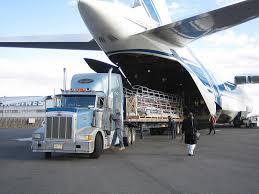Air Freight Forwarding Market expansion influenced by global manufacturing supply chain shifts

The Air Freight Forwarding Market is experiencing a notable expansion as global manufacturing supply chains undergo structural shifts. Driven by geopolitical changes, trade policy evolution, and the urgent need for more resilient sourcing networks, manufacturers are diversifying production bases, and air freight is emerging as a strategic logistics enabler in this transition.
Manufacturing Diversification Boosts Air Freight Volumes
For decades, manufacturing concentrated in low-cost regions like China provided stability and efficiency to global trade. However, recent events—ranging from U.S.-China trade tensions and Brexit to pandemic disruptions—have forced companies to reassess their supply chain dependencies. As a result, the global manufacturing landscape is shifting toward a “China+1” strategy, nearshoring, and regional production hubs.
This diversification has increased the complexity and fragmentation of supply chains. To maintain fast delivery timelines and mitigate risks associated with longer transit routes, businesses are increasingly relying on air freight forwarding for critical raw materials, components, and finished goods. The ability of air freight to bypass port congestion and deliver with unmatched speed makes it indispensable in this context.
Nearshoring and Just-in-Time Models Accelerate Adoption
Nearshoring initiatives, particularly in North America and Europe, are driving demand for agile logistics. Manufacturers moving production closer to end markets still rely on global suppliers for niche parts and materials, which often must be flown in on short notice to avoid production halts. This has created a surge in demand for air freight solutions that can integrate with just-in-time (JIT) inventory models.
The precision and reliability of air freight make it the preferred option for industries like automotive, aerospace, and electronics, where supply delays translate directly into revenue loss. Air freight forwarders are responding with faster customs clearance procedures, integrated shipment tracking, and more responsive customer support tailored for JIT operations.
Southeast Asia and South Asia Gain Prominence
As manufacturers move operations out of China to mitigate concentration risk, countries like Vietnam, India, Indonesia, and Bangladesh are becoming increasingly vital links in global production chains. These emerging manufacturing hubs often lack robust ocean freight infrastructure, making air freight a critical lifeline, especially for high-value and time-sensitive exports.
Air freight forwarders are expanding their footprint in these regions by developing regional air cargo hubs, enhancing intermodal connectivity, and offering end-to-end supply chain services. Additionally, investments in airport logistics facilities in cities like Ho Chi Minh City, Chennai, and Dhaka are supporting this shift and enabling efficient outbound air cargo operations.
Air Freight as a Strategic Buffer in Disruption-Prone Supply Chains
Modern supply chains are more vulnerable than ever to geopolitical shocks, climate events, and pandemic-like disruptions. As a strategic response, companies are adopting air freight as a buffer mechanism that enables rapid replenishment of stock and timely delivery of critical items when other logistics modes fail.
Air freight forwarders now offer agile capacity planning and crisis logistics services, allowing manufacturers to react swiftly to production interruptions. Temporary capacity surges, chartered cargo flights, and dynamic route reallocation are all being used to mitigate disruption risks.
Multimodal Integration Enhances Efficiency
The expansion of air freight forwarding is also being supported by better multimodal integration. Manufacturers are combining air freight with rail and road services to optimize costs without compromising on speed. In regions like the EU and North America, forwarders are building multimodal corridors that seamlessly connect air hubs with inland destinations.
This integration reduces dwell time, shortens delivery cycles, and supports the shift toward omnichannel fulfillment. Logistics providers are leveraging digital twins and AI-powered route optimization tools to streamline cargo transitions across different transportation modes.
Technology Adoption to Manage Complex Supply Chains
With manufacturing and sourcing becoming more distributed, real-time visibility and coordination have become essential. Air freight forwarders are increasingly deploying cloud-based logistics platforms, blockchain documentation, and AI-enabled predictive analytics to manage more complex and fragmented supply chains.
These technologies enable forwarders to offer accurate estimated time of arrivals (ETAs), traceability, proactive exception handling, and seamless data sharing across stakeholders. This tech-driven evolution is essential for manufacturers transitioning to agile, decentralized production networks.
Regulatory Compliance and Trade Facilitation
As production shifts across borders, manufacturers must navigate a patchwork of regulatory environments, trade agreements, and customs protocols. Air freight forwarders play a critical role in ensuring compliance and trade facilitation by offering expertise in customs brokerage, documentation, and certifications.
Forwarders with global networks and in-house regulatory teams are better positioned to support cross-border shipments efficiently. This compliance capacity is especially crucial for industries with strict quality standards or dual-use goods.
Outlook: Agile Logistics for Dynamic Manufacturing Ecosystems
Looking ahead, the expansion of the air freight forwarding market will remain closely tied to the continued evolution of global manufacturing networks. As companies prioritize resilience, agility, and responsiveness in their supply chains, the need for time-definite and secure logistics will intensify.
The future of air freight will be characterized by greater specialization, with providers offering industry-specific solutions, smarter route planning, and enhanced automation. Companies that align with forwarders capable of adapting to changing manufacturing realities will gain a significant competitive edge.
Conclusion
The shifting structure of global manufacturing is reshaping the logistics landscape, and air freight forwarding stands at the forefront of this transformation. From supporting new production hubs to enabling JIT inventory flows and offering rapid disruption recovery, air freight is becoming a strategic tool for modern manufacturers. As the supply chain continues to evolve, air freight forwarders must innovate in speed, flexibility, and technological sophistication to keep pace with the dynamic demands of global industry.
- Art
- Causes
- Crafts
- Dance
- Drinks
- Film
- Fitness
- Food
- Games
- Gardening
- Health
- Home
- Literature
- Music
- Networking
- Other
- Party
- Religion
- Shopping
- Sports
- Theater
- Wellness


